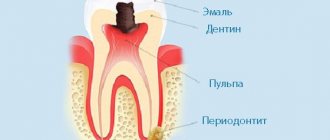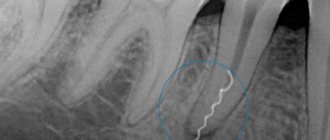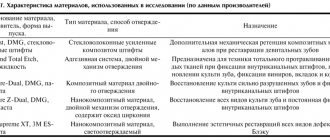Increased tooth sensitivity after caries treatment is a common problem. Teeth begin to react to hot and cold, to certain types of foods. Sometimes the sensitivity of teeth increases so much that discomfort occurs with any impact on them. Find out how to eliminate these unpleasant sensations in the article.
In this article
- Increased sensitivity of teeth during deep stages of caries
- Methods of dental treatment for caries
- Reasons for increased tooth sensitivity after caries treatment
- Precautions to reduce tooth sensitivity during rehabilitation
- What to do if tooth sensitivity does not go away for a long time?
Caries is a dental disease in which teeth begin to deteriorate inside and out. If it is not treated promptly, then gradually the dentin inside the teeth softens, demineralization occurs, and carious cavities form. The development of caries is caused by bacteria, which must be removed daily by brushing your teeth.
Increased sensitivity of teeth during deep stages of caries
Caries develops gradually - at first, a person may not even suspect that he has this problem if he does not practice regular dental examinations. There are four stages of the carious process:
- the so-called “chalk stain”, when the enamel changes color and acquires a darker shade - grayish or milky;
- superficial: teeth begin to react to hot, cold, sour, etc., the stain becomes rough;
- medium caries, when carious cavities increasingly destroy dentin, and pain occurs more often and is felt more strongly;
- deep: the carious process begins to affect the pulp, a cavity is formed bordering the dental nerve.
If caries is not treated, its complications are inevitable, for example, pulpitis, periodontitis, and as a result, teeth can simply be lost.
Content:
- Reasons 1.1. Caries, pulpitis 1.2. Poorly performed dental treatment 1.3. Bleaching 1.4. External factors 1.5. Internal factors
- How does hyperesthesia develop?
- Qualified help
- How to reduce the likelihood of developing hyperesthesia - preventive measures
If a tooth reacts to cold or hot, this cannot be regarded as a normal option. This condition is usually a consequence of inflammation or thinning of the enamel. You should not guess and try to fix the situation yourself. The most reasonable thing is to make an appointment with a dentist and undergo a simple diagnosis. It will help you understand what causes discomfort and how you can get rid of it.
Methods of dental treatment for caries
The method of treating this disease depends on its stage. Let's take a closer look at what measures are applied at each stage:
- Chalk stain. In this case, it is still possible to carry out therapy without resorting to a drill and filling. Typically, enamel remineralization is carried out using formulations with a high content of sodium fluoride and calcium gluconate.
- At the superficial stage, it may sometimes be necessary to install fillings, and remineralization of the enamel is also carried out.
- In the middle stage, it is necessary to clean carious cavities and then fill them to protect them from bacteria.
- Deep caries is treated in several stages. First, the damaged dental structures are cleaned, then a temporary filling is installed. On the second visit, if no negative reactions occur, the doctor puts a permanent filling, grinds and polishes the tooth.
A competent dentist will try to preserve the patient’s teeth while treatment is possible. He will use the removal of carious units only at such a degree of destruction of dental structures that it is no longer possible to save them.
How to treat pain after a filling is installed
The only thing you can do on your own if discomfort occurs is to take analgesics. It is advisable to use complex drugs with analgesic and anti-inflammatory effects. This could be Ketorol or Nimesil.
If the pain does not go away within 3 days, you cannot do without visiting a doctor. An x-ray of the damaged tooth is first taken to determine its condition. When treating complicated caries, the dentist performs the following sequence of actions:
- Anesthesia.
- Removing the previous filling. After this, access to the channels is freed.
- Mechanical treatment of the tooth cavity, cleaning of the canals. It is carried out in conjunction with irrigation with antiseptics.
- Filling (using temporary or permanent filling).
If a temporary tooth filling is placed, another visit will be required for a permanent restoration. Pulpitis is treated in the same way. If the cause of the problem is hyperextension, complete sanitation of the oral cavity is not enough. Strengthening enamel includes:
- the use of potassium salt preparations (used to strengthen dental hard tissues);
- deep fluoridation of enamel.
Deep fluoridation is recommended after professional teeth cleaning.
After this, you need to carefully follow your doctor’s recommendations for dental care. It involves the use of a paste with a low level of abrasives or a special gel for cleaning teeth. The brush should be soft or extremely soft. After brushing, it is recommended to use special rinses for sensitive teeth.
In case of increased sensitivity, toothpicks and floss should be used extremely carefully so as not to injure the gums.
Reasons for increased tooth sensitivity after caries treatment
In the stage of deep caries, dental structures are severely destroyed both externally and internally. Fillings installed during treatment can sometimes occupy more than 50% of the surface. After treatment of deep caries, the sensitivity of filled teeth often increases. They begin to react to sweets, cold or hot food, and exposure to cool air. This is a normal occurrence during the rehabilitation period. Let's look at why tooth sensitivity increases after treatment of deep caries.
Too long (more than 15 seconds) exposure of dentin to orthophosphoric acid, which is used before installing a filling. Acid promotes the opening of dentinal tubules, increasing the permeability of dentin to the adhesive and composite. Sometimes an under-polymerized composite penetrates too deeply into the dentinal tubules, causing an irritating effect on the pulp.
Excessive filling height is a common cause of increased tooth sensitivity after caries treatment. Even an extra half a millimeter can cause discomfort, since the pressure on the sealed surface increases when the teeth are closed. This is usually discovered after the local anesthesia wears off. In this case, there is no need to be shy, but you should definitely consult a doctor so that he can remove the excess material.
Each patient’s body reacts individually to filling materials, so sensitive teeth after caries treatment are normal. In most cases, the pain subsides and goes away within one to two weeks. At this time, you need to adhere to certain rules so as not to prolong the rehabilitation period.
Why does a tooth react to hot and cold?
The human tooth has a rather complex structure. It consists predominantly of dentin - mineralized, hard tissue penetrated by dentinal tubules. The tubules communicate directly with the pulp - the internal connective tissue of the tooth, equipped with a large number of nerve endings that immediately respond to external stimuli. On top, dentin is covered with enamel - the hardest tissue in the human body, protecting the tooth from damage and infection. But as soon as the tooth enamel is damaged or thinned, external irritants through the dentin tubules begin to affect the nerve endings of the pulp and the person experiences pain.
A tooth can hurt for various reasons. Often, they are not visible to the eye, but lead to thinning or damage to the hard tissues of the tooth, thereby affecting the nerves of the pulp. Therefore, even an outwardly healthy tooth or a tooth that has already been treated and filled can be very painful when eating hot or cold.
Hyperesthesia is not a disease, but a symptom indicating the presence of some dental pathology. Increased sensitivity of teeth develops as a result of damage to the hard tissues of the tooth caused by a destructive process of carious, non-carious, mechanical origin or as a result of demineralization.
Precautions to reduce tooth sensitivity during rehabilitation
After caries treatment, the patient needs to follow simple precautions that will help quickly restore normal reactions:
- Use desensitizing toothpastes containing high doses of fluoride, potassium chloride, potassium nitrate or other remineralizing elements to help reduce tooth sensitivity. Pastes with abrasive particles are prohibited at this time.
- During the rehabilitation period, toothbrushes should be used with medium or low bristle stiffness; the front teeth should be brushed with strictly progressive movements up and down, and chewing teeth should be brushed with circular movements clockwise.
- Foods high in vitamin D (milk, fish, egg yolk, cheese, liver) should be added to your diet to further strengthen tooth enamel.
- To rinse the cavity, you can use various formulations, for example, tea tree oil (3 drops per glass of water). It has high antibacterial properties, prevents the development of caries, and eliminates unpleasant odors.
- The simultaneous consumption of cold and hot foods is not recommended; overly sour or sweet foods, as well as coloring foods, should be avoided. After every meal you need to rinse your mouth.
If sensitive teeth still cause significant discomfort, you can take non-steroidal anti-inflammatory drugs - consult your dentist.
How to reduce the likelihood of developing hyperesthesia - preventive measures
High sensitivity is a condition that can be avoided in most cases. To do this you need:
- Brush morning and evening, using a medium-hard brush and high-quality toothpaste.
- Use dental rinses on a regular basis.
- Carry out a home course of enamel remineralization two to three times a year. For this purpose, you should use a special strengthening gel.
- Undergo professional hygiene procedures annually. During this procedure, the upper layers of the crown are cleared of plaque and stone. Due to this, they begin to better absorb beneficial microelements.
- Eat properly. You can’t eat a lot of sweets or drink carbonated drinks.
- Periodically take a complex of vitamins and minerals, selected by your doctor.
If you properly care for your teeth, the risk that they will react sharply to cold, hot, sour, and sweet foods will be minimal. Pay enough attention to the health of your smile and you won’t have to suffer from severe pain.
What to do if tooth sensitivity does not go away for a long time?
On average, discomfort in the oral cavity should stop after two weeks; for some, this period may be a little longer due to individual characteristics. But if tooth sensitivity persists for a month or longer after caries treatment, this is a reason to definitely consult your doctor.
It is important to accurately describe all your pain sensations so that the dentist can identify the source of the problem at an early stage and eliminate it. It may be that the filling has cracked or the composite material has spread, or this material is simply not suitable. In this case, the filling is removed and another one is placed, or a spacer that reduces sensitivity is placed between it and the inner dental tissue.
If, after the anesthesia has worn off, you feel the sharp edge of the filling that touches the surrounding tissues - tongue, gum, cheek, this means that it is not polished enough. In this case, there is a risk that there is a gap between the filling and the tooth, in which plaque and microbes will accumulate over time, provoking the re-development of caries. To eliminate the problem, the dentist will polish the problem area and thereby prevent possible consequences.
The reasons for tooth sensitivity after caries treatment can be different, and in this case it is important for the patient not to delay a visit to the doctor if they have been bothering them for a long time.
Diagnostics
The occurrence of discomfort after cold or hot food is one of the signs that the filling was performed incorrectly. If in doubt, just drink a glass of cold water. With caries, pain will occur immediately, with pulpitis it will appear over time. If any painful symptoms occur, you should immediately make an appointment with your doctor for a follow-up appointment. Read more about identifying hidden caries in the article.
Don't expect the problem to go away over time. Complicated caries and pulpitis progress over time, leading to tooth destruction.
To identify damaged areas, a special drug called “Caries Control” is used. After application to the tooth cavity, the dead areas are painted in a contrasting color. After this it is easier to remove them completely.










